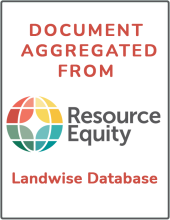Land Library Search
Through our robust search engine, you can search for any item of the over 73,000 highly curated resources in the Land Library.
If you would like to find an overview of what is possible, feel free to peruse the Search Guide.
/ library resources
Showing items 1 through 9 of 58.This paper examines the impact of land reform on agricultural productivity in Tajikistan. Recent legislation allows farmers to obtain access to heritable land shares for private use, but reform has been geographically uneven.
The Royal government of Bhutan launched the Tenth Five Year Plan that outlines strategies from 2008-2013 to reduce poverty and to increase education initiatives.
In a world of food abundance, millions of people suffer from poor nutrition. In some parts of the world, the poor have inadequate access to energy from food to meet their energy requirements.
In many developing countries, supermarkets are growing fast. This growth entails a change in the food chain that supplies fresh foods from farmers and processed foods via agroprocessors. Farmers who wish to participate in the food chain have to adapt to the supermarkets' requirements.
Across vast areas of the world, human activity has degraded once fertile and productive land. Deforestation, overgrazing, continuous farming and poor irrigation practices have affected almost 2 billion hectares worldwide, threatening the health and livelihoods of over one billion people.
Following from the Comprehensive Assessment of Water Management in Agriculture project, this book examines the relationships and linkages between land use and water management and social systems.
Divided into three parts, this collaborative work looks at the varied challenges brought about as a result of corruption in the water sector. It also looks at recent research conducted and provides an overview of the water sector corruption challenges in country profiles across the globe.
Forestry education in recent years has largely failed to adequately respond to the dynamics in forestry practice, the demands of the job market and the challenges of new global forestry paradigms.






